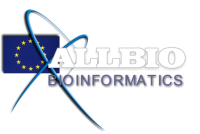
If you are interested in participating this Coordination Action please contact us!
This shows you the differences between two versions of the page.
| Both sides previous revisionPrevious revisionNext revision | Previous revision | ||
| public:ulb [2012/09/21 07:55] – [Prof. Jacques van Helden] jvanheld | public:ulb [2019/02/12 09:04] (current) – external edit 127.0.0.1 | ||
|---|---|---|---|
| Line 9: | Line 9: | ||
| === Bioinformatics approaches and tools === | === Bioinformatics approaches and tools === | ||
| - | == Regulatory Sequence Analysis Tools (RSAT, http:// | + | == Regulatory Sequence Analysis Tools (RSAT) == |
| + | Web site: [[http:// | ||
| A software suite dedicated to the analysis of motifs in cis-regulatory sequences. RSAT combines several original algorithms for detecting cis-regulatory motifs in promoters of co-expressed genes (transcriptome data), detection of phylogenetic footprints (conserved elements in promoters of orthologous genes), analysis of high-throughput sequencing data (ChIP-seq) or full genomes. To my best knowledge, RSAT is currently the most complete Web resource worldwide for the analysis of regulatory sequences. | A software suite dedicated to the analysis of motifs in cis-regulatory sequences. RSAT combines several original algorithms for detecting cis-regulatory motifs in promoters of co-expressed genes (transcriptome data), detection of phylogenetic footprints (conserved elements in promoters of orthologous genes), analysis of high-throughput sequencing data (ChIP-seq) or full genomes. To my best knowledge, RSAT is currently the most complete Web resource worldwide for the analysis of regulatory sequences. | ||
| Line 18: | Line 19: | ||
| Since 1999, I developed bioinformatics approaches applying graph theory methods (path finding, subgraph extraction) to discover metabolic pathways in reaction networks (built by compiling all known reactions, their substrates and products). Typical applications are the analysis of metabolic regulation by inferring pathways from groups of co-expressed enzymes, or the reconstruction of bacterial metabolism by building pathways from operons, regulons or groups of genes co-occurring across genomes (phylogenetic profiles). | Since 1999, I developed bioinformatics approaches applying graph theory methods (path finding, subgraph extraction) to discover metabolic pathways in reaction networks (built by compiling all known reactions, their substrates and products). Typical applications are the analysis of metabolic regulation by inferring pathways from groups of co-expressed enzymes, or the reconstruction of bacterial metabolism by building pathways from operons, regulons or groups of genes co-occurring across genomes (phylogenetic profiles). | ||
| - | == Network analysis tools (NeAT, http:// | + | == Network analysis tools (NeAT) == |
| - | Since 2005, the RSAT suite has been complemented by a series of specialized tools for the analysis of biomolecular networks. The « Network Analysis Tools » (NeAT, http:// | + | Web site: [[http:// |
| + | |||
| + | Since 2005, the RSAT suite has been complemented by a series of specialized tools for the analysis of biomolecular networks. The software suite Network Analysis Tools (NeAT) | ||
| == Assessment of bioinformatics approaches == | == Assessment of bioinformatics approaches == | ||
| Line 29: | Line 32: | ||
| ==== Publications ==== | ==== Publications ==== | ||
| + | === Recent publications === | ||
| + | |||
| + | * Thomas-Chollier M, Darbo E, Herrmann C, Defrance M, Thieffry D, van Helden J. (2012). A complete workflow for the analysis of full-size ChIP-seq (and similar) data sets using peak-motifs. Nat Protoc 7(8): 1551-1568 [[http:// | ||
| + | 22836136]] | ||
| + | |||
| + | * Jacques van Helden, Ariane Toussaint and Denis Thieffry (2012). Bacterial Molecular Networks. Methods in Molecular Biology, Volume 804 (28 chapters) [[http:// | ||
| + | |||
| + | * van Helden, J., Toussaint, A. and Thieffry, D. (2012). Bacterial molecular networks: bridging the gap between functional genomics and dynamical modelling. Methods Mol Biol 804, 1-11 [[http:// | ||
| + | |||
| + | * Faust, K. and van Helden, J. (2012). Predicting Metabolic Pathways by Sub-network Extraction. Methods Mol Biol 804, 107-30.[[http:// | ||
| + | |||
| + | * Thomas-Chollier M, Herrmann C, Defrance M, Sand O, Thieffry D, van Helden J. (2012). RSAT peak-motifs: | ||
| + | == Full list of publications == | ||
| + | [[http:// | ||